Do You Need Juniper Berries for Corned Beef Brine
Home-cured corned beef is extremely flavorful, incredibly tender and easier to make than you might think! Just make sure to plan ahead: this corned beef recipe calls for one week of dry brining!
Corned beef and cabbage is an American tradition associated with St. Patrick's day and something I start craving every time March rolls around. This year, instead of buying the pre-brined version, we decided to try our hand at curing our own brisket. Now that the results are in I can tell you that making corned beef from scratch was well worth the effort and actually turned out to be much easier than I anticipated!
And one side note before we get into the details: If you're interested in learning more about corned beef's connections with Ireland and how it became associated with St. Patrick's Day, this article by The Smithsonian is an excellent read!
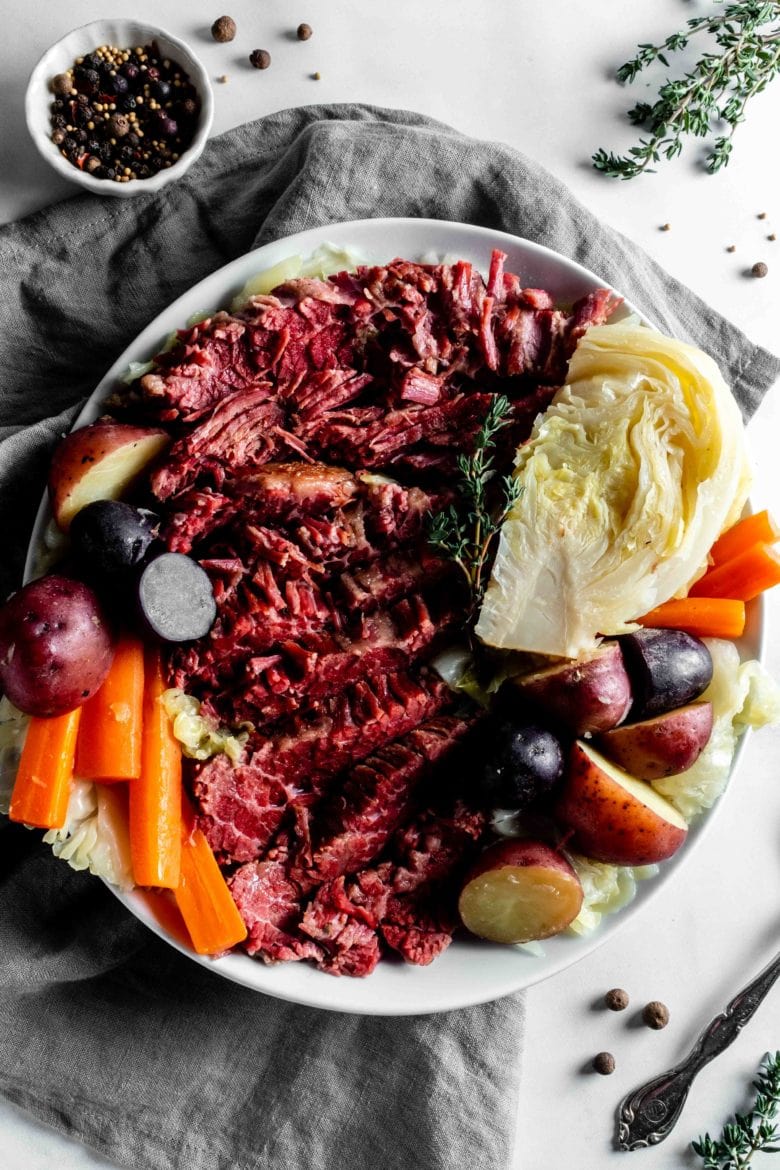
home curing and using pink salt
Corned beef is made by salt-curing brisket with a delicious blend of spices. The word corned actually comes from the coarse salt grains that were originally used to preserve and tenderize the meat, which were at the time referred to as corns of salt!
When it comes to curing your brisket, you can either use a wet brine (where the meat is submerged in water along with the spices and salt) or a dry brine (where the salt and spices are rubbed into the meat). Although a lot of homemade corned beef recipes call for a wet brine, we opted for a dry brine for several reasons. The initial rationale was simply the fact that we currently live in a small cabin with limited fridge space and dry brining takes up much less room. But another advantage of opting for a dry brine is that the meat will sit in its own liquid drawn out by the salt (resulting in a more concentrated flavor!) instead of being diluted by the water of a wet brine.
In addition to kosher salt and spices, you'll also need a bit of curing salt for the rub. Pink curing salt (also called prague powder) is added to the rub to prevent the growth of unwanted bacteria. It's dyed pink so that it can easily be distinguished from table salt. The curing salt enhances the brisket's flavor and is what gives corned beef its characteristic color. Just make sure to use the right amount! You don't need much at all — one teaspoon per five pounds of meat is the recommended ratio.
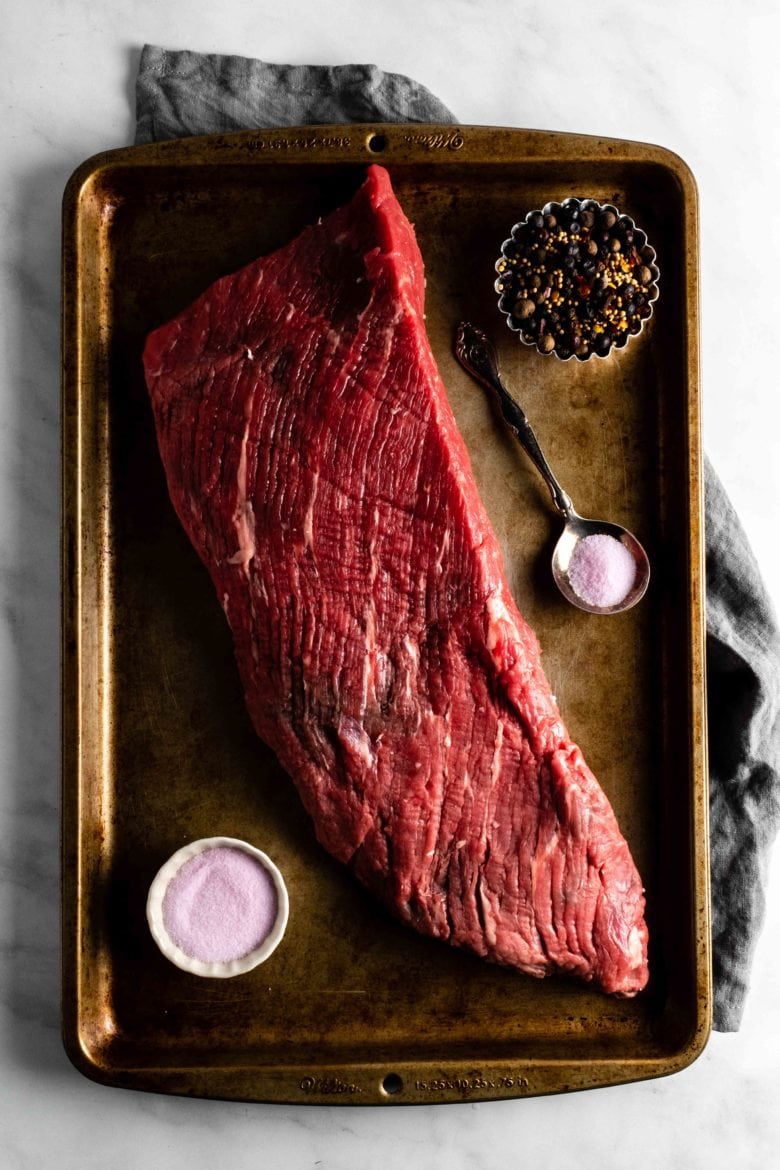
the spices
When it comes to spices, you have a lot of freedom to tailor the blend to your taste. While I've included a recipe for the mixture of spices that we used, you can definitely mix and match with your favorite ingredients. Feel free to leave out the juniper berries if you don't have any on hand or add a bit of cinnamon or coriander for an extra flavor boost. I'm definitely not too particular here and just used what we had in our cupboards!
In addition to brown sugar, our lineup of spices included:
- whole allspice
- juniper berries
- black peppercorns
- mustard seeds
- cloves
- red pepper flakes
- bay leaves
Once you've settled on your spices, you'll want to toast them briefly (only about a minute or two) in a dry skillet to intensify their flavors. Then briefly grind them using a spice grinder, mortar and pestle or even a coffee grinder like I used! Here you want a coarse grind; the spices shouldn't be too powder-like. Combine your spice blend with the kosher salt, curing salt and brown sugar and rub the mixture into the meat to evenly coat. Then just place your brisket in a sealed plastic bag and let it sit for a week!
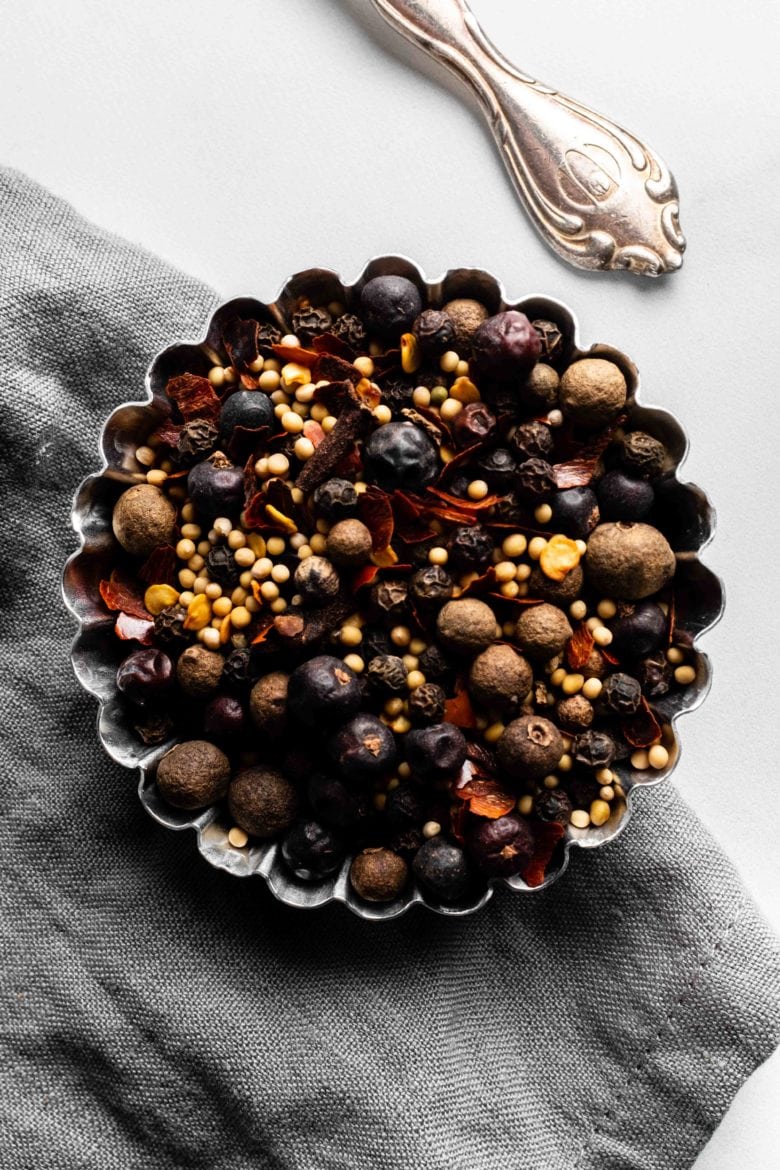
simmer you corned beef to perfection
Now that we've successfully cured the brisket, it's finally time to enjoy it! Start by thoroughly rinsing the brisket under cold water and removing the salt and spices. Try to remove as much as you can; the corned beef will still be quite salty!
To cook the corned beef, place it in a large pot and fill with water so that the brisket is completely submerged. Add an onion and a few cloves of garlic for flavor and bring the water to a boil. Reduce heat, cover and simmer. About four hours was the perfect amount of time for our brisket to reach tender, juicy perfection, but it will definitely depend on the amount of meat you're cooking. Make sure to check the corned beef every hour and add more water if needed so that the brisket is completely submerged. This will help to ensure a tender end result!
While it's optional, I also like to add a few spices to the pot for some additional flavor. For this recipe, I used bay leaves, fresh thyme, allspice, juniper berries, peppercorns and cloves. One tip: use cheesecloth to form a little pouch for the spices and tie them up with kitchen twine. This will make it much easier to remove them before eating!
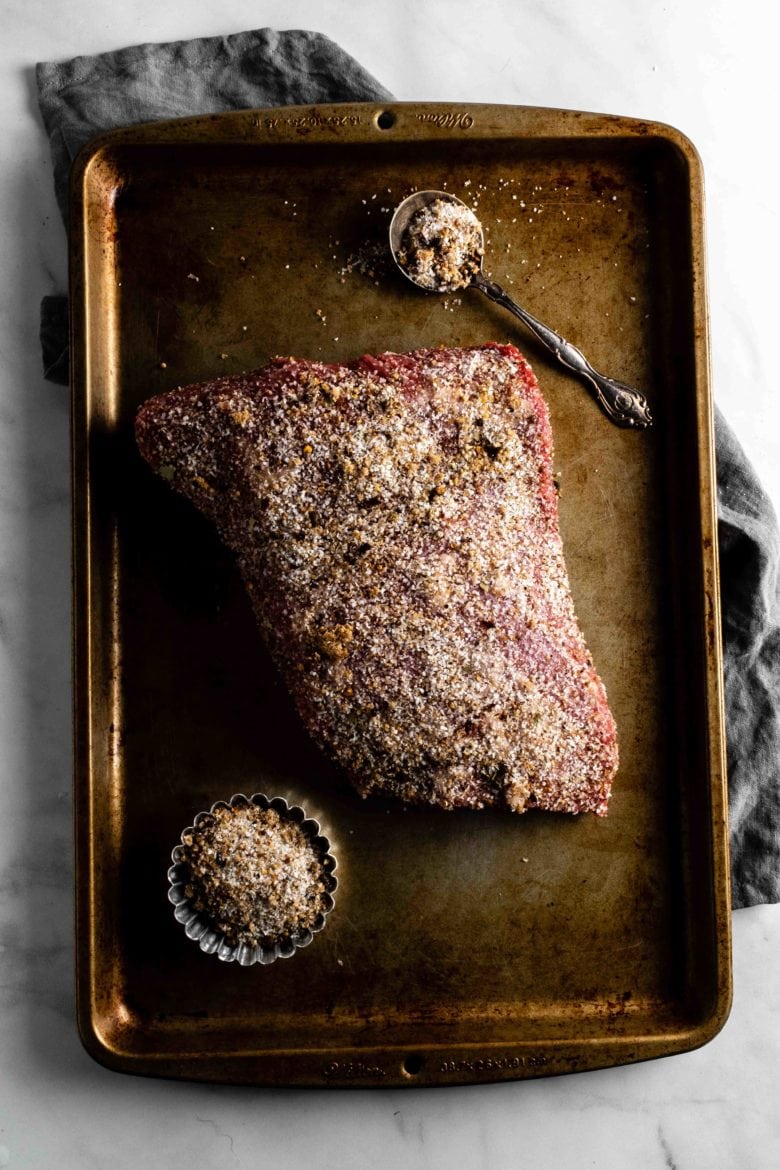
what to serve with corned beef
Our favorite way to serve corned beef is with various vegetables. Cabbage is a must and potatoes and carrots usually make an appearance as well. The easiest (and most flavorful) way to cook these veggies is just to add them to the pot alongside the corned beef during the last 30 minutes of cooking. They'll absorb the flavorful broth and be incredibly delicious!
If you're looking for a separate side dish, colcannon is also an excellent option. Corned beef is wonderful served over a plate of the Irish mashed potatoes with kale!
And what about leftovers? This recipe does make quite a lot of corned beef. After our initial feast, we've been repurposing the leftovers into corned beef hash and reuben sandwiches. We've also got the cooking liquid tucked away in our freezer for the next time we want to make soup. It's a bit on the salty side, but after adding a few cups of water it turns into an insanely delicious base for your favorite soups and stews!
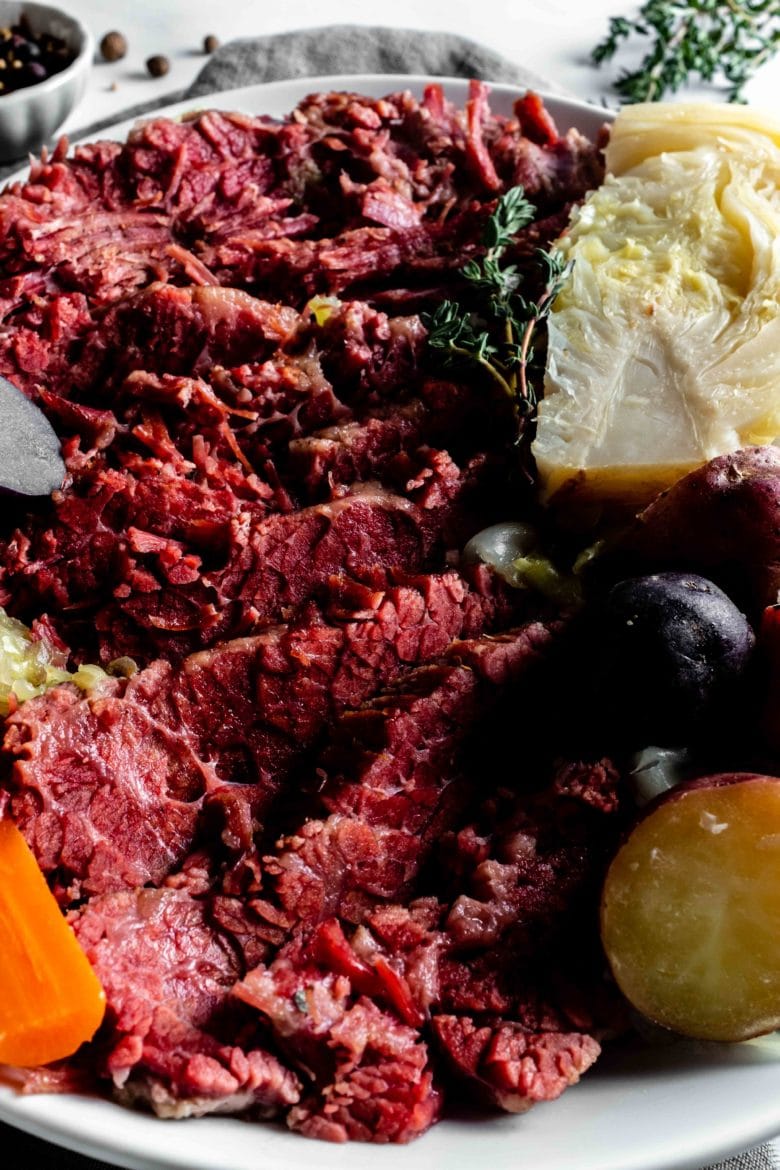
Looking for more slow cooked recipes perfect for Sunday dinner? Give these a try!
- svíčková | czech beef sirloin in vegetable cream sauce
- beef short rib ragu
- borscht
- fesenjan | iranian pomegranate chicken stew
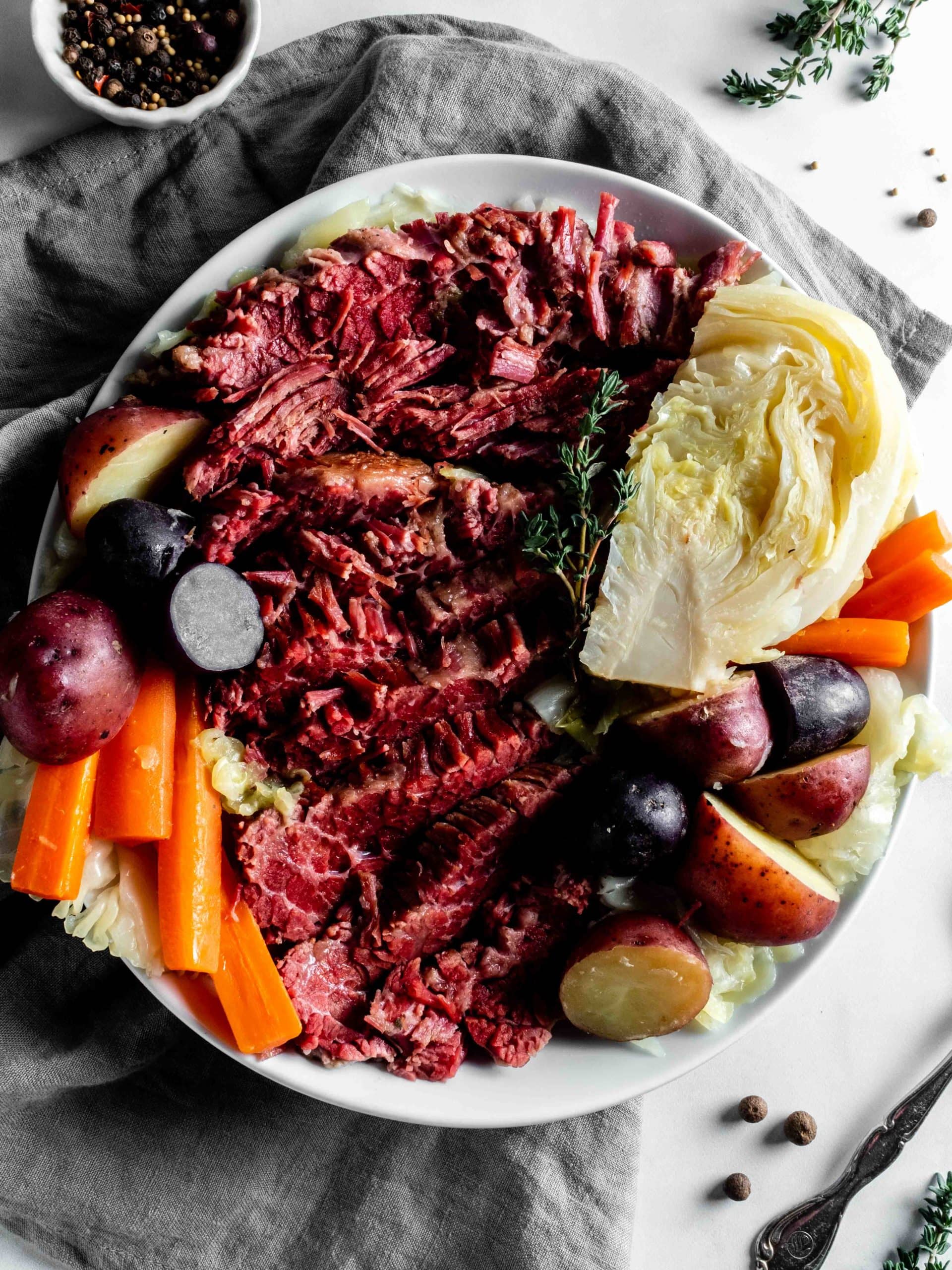
ingredients
dry brine
- brisket 4-5 lbs (2 kg)
- kosher salt ¾ c (200 g)
- pink curing salt 1 tsp (5 g)
- brown sugar ¼ c (50 g)
- allspice berries 1 tbsp
- juniper berries 1 tbsp
- black peppercorns 1 tbsp
- mustard seeds 1 tbsp
- cloves 8 whole
- red pepper flakes 1 tsp
- bay leaves 4 leaves
corned beef and cabbage
- onion (quartered) 1 large
- garlic 3 cloves
- bay leaves 2 leaves
- allspice berries 4 whole
- juniper berries 4 whole
- black peppercorns 4 whole
- cloves 4 whole
- cabbage 1 head
- baby potatoes 1.5 lbs (700 g)
- carrots 4 large
instructions
dry brine
- Toast the allspice, juniper berries, peppercorns, mustard seeds, cloves, red pepper flakes and bay leaves in a dry skillet over medium heat just until fragrant (1-2 minutes). Make sure not to let them burn! Using a spice grinder or mortar and pestle, process the spices to a coarse grind. Combine with the kosher salt, pink salt and brown sugar.
- Trim the brisket of fat and rub the spice mixture all over the brisket to thoroughly coat. Place in a sealed plastic bag and refrigerate for seven days. Flip the meat once daily.
corned beef and cabbage
- Thoroughly rinse the brisket under cold water to remove the seasonings.
- Place the corned beef in a large pot along with the onion and garlic. Completely cover with water.
- Bring the mixture to a boil, reduce heat and cover. Simmer for 4 hours or until tender. Check occasionally to make sure the entire brisket is submerged and add more water as necessary.
- While the corned beef is cooking, prepare the vegetables. Cut the potatoes in half. Cut the cabbage into wedges. Slice the carrots into long, thin pieces. Add the vegetables to the pot for the last 30 minutes of cooking.
- Remove meat and vegetables from the pot. Slice the corned beef across the grain. Spoon a bit of cooking liquid over the top if desired.
Did You Make This Recipe?
This post may contain affiliate links through which we may earn a small commission at no additional cost to you. We only recommend products that we genuinely love and would use ourselves.
Source: https://whiskedawaykitchen.com/corned-beef/
0 Response to "Do You Need Juniper Berries for Corned Beef Brine"
Post a Comment